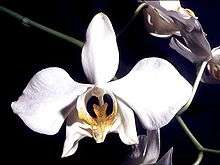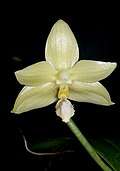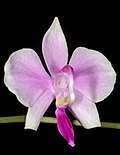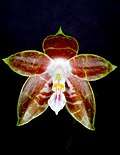Phalaenopsis
Phalaenopsis /ˌfælɪˈnɒpsɪs/ Blume (1825), commonly known as moth orchids,[2] is a genus of about seventy species of plants in the family Orchidaceae. Orchids in this genus are monopodial epiphytes or lithophytes with long, coarse roots, short, leafy stems and long-lasting, flat flowers arranged in a flowering stem that often branches near the end. Orchids in this genus are native to India, Taiwan, China, Southeast Asia, New Guinea and Australia with the majority in Indonesia and the Philippines.
| Moth orchids | |
|---|---|
 | |
| Phalaenopsis amabilis | |
| Scientific classification | |
| Kingdom: | Plantae |
| Clade: | Tracheophytes |
| Clade: | Angiosperms |
| Clade: | Monocots |
| Order: | Asparagales |
| Family: | Orchidaceae |
| Subfamily: | Epidendroideae |
| Tribe: | Vandeae |
| Subtribe: | Aeridinae |
| Genus: | Phalaenopsis Blume[1] |
| Type species | |
| Phalaenopsis amabilis Blume (1825) | |
| Synonyms[1] | |
| |
Description
Orchids in the genus Phalaenopsis are monopodial epiphytic, sometimes lithophytic herbs with long, coarse roots and short leafy stems hidden by overlapping leaf bases. The leaves are usually arranged in two rows, relatively large and leathery, oblong to elliptic and sometimes succulent. A few to many, small to large, long-lasting, flat, often fragrant flowers are arranged on erect to hanging racemes or panicles. The sepals and petals are free from and spread widely apart from each other. The lateral sepals are usually larger than the dorsal sepal and the petals much wider than the sepals. The labellum is joined stiffly to the column and has three lobes. The side lobes are erect and more or less parallel to each other and the middle lobe sometimes has a pair of appendages or antennae.[2][3][4][5][6]
Taxonomy and naming
The genus Phalaenopsis was first formally described in 1825 by Carl Ludwig Blume and the description was published in Bijdragen tot de flora van Nederlandsch Indië.[1][7] The name Phalaenopsis is derived from the Ancient Greek word phalaina (φαλαινα) meaning "a kind of moth"[8]:535 with the suffix -opsis meaning "having the appearance of" or "like".[8]:483[9]
The genus name is abbreviated Phal. horticulturally.[10]
Distribution
Species of Phalaenopsis are found from India to southern China, Indochina, Malaysia and from Indonesia to the Philippines and New Guinea. There is a single species endemic to Queensland. The greatest disversity of phalaenopsis occurs in Indonesia and the Philippines.
Species
The following is a list of Phalaenopsis species accepted by the World Checklist of Selected Plant Families as at January 2019:
| Image | Name | Distribution | Elevation (m) |
|---|---|---|---|
 | Phalaenopsis amabilis (L.) Blume 1825 | East Malaysia to Papuasia | 0– 600 meters |
 | Phalaenopsis amboinensis J.J.Smith 1911 | Ambon Island, Sulawesi, Papua and New Guinea and Indonesia | |
 | Phalaenopsis aphrodite Rchb.f 1862 | Philippine Islands, Sulu Archipelago, and Taiwan, China | |
 | Phalaenopsis appendiculata Carr 1929 | Pahang, Malaysia to northeastern Borneo | |
 | Phalaenopsis bastianii O.Gruss & L.Röllke 1991 | the Philippines - Luzon, in the Sulu Archipelago | |
 | Phalaenopsis bellina Christenson 1995 | Borneo | 200 meters and below |
| Phalaenopsis braceana (Hook. f.) Christenson 1986 | Eastern Himalayas, Bhutan, Myanamar, Thailand, Vietnam, China - Yunnan | 1100 – 2100 meters. | |
 | Phalaenopsis buyssoniana Rchb. f. 1888 | Indochina, Thailand, and Vietnam | |
| Phalaenopsis cacharensis (Barbhuiya, B.K.Dutta & Schuit.) Kocyan & Schuit. 2014 | India (Cachar, Assam) | ||
 | Phalaenopsis celebensis Sweet 1980 | Sulawesi | |
 | Phalaenopsis chibae T.Yukawa 1996 | Vietnam | 400 – 600 meters |
_Holttum%2C_Orchid_Rev._73-_409_(1964)_(36008796681).jpg) | Phalaenopsis cochlearis Holttum 1964 | Malaysia and Sarawak, Borneo | 450 – 700 meters |
 | Phalaenopsis corningiana Rchb. f. 1879 | Borneo | 450 – 610 meters |
 | Phalaenopsis cornu-cervi (Breda) Blume & Rchb.f. 1860 | India, Myanamar, Thailand, Laos, Vietnam, Nicobar Islands, Malaysia, Java, Borneo, Sumatra, and the Philippines | 1000 meters and below |
 | Phalaenopsis deliciosa Rchb. f. 1854 | India to SE Asia, Java, Sumatra, Borneo and the Philippines | 600 meters and below |
| Phalaenopsis difformis (Wall. ex Lindl.) Kocyan & Schuit. 2014 | Assam India, eastern Himalayas, Nepal, western Himalayas, Myanmar, Thailand, Malayasia, Laos, central and southern China, Vietnam, Borneo and Sumatra | 300 – 1600 meters | |
 | Phalaenopsis doweryënsis Garay & Christenson 2001 | Sabah | 150 meters |
 | Phalaenopsis equestris [Schauer]Rchb.f 1849 | Taiwan - Hsiao Lan Yü to the Philippines | 0 – 300 meters. |
 | Phalaenopsis fasciata Rchb.f 1882 | the Philippines | |
 | Phalaenopsis fimbriata J.J. Sm. 1921 | Java, Sumatra and Sarawak | 790 – 1300 meters. |
 | Phalaenopsis finleyi Christenson 2011 | Thailand and Burma | |
 | Phalaenopsis floresensis Fowlie 1993 | island of Flores in Indonesia | 150 – 500 meters |
 | Phalaenopsis fuscata Rchb. f. 1874 | Sumatra, Peninsular Malaysia, Borneo, to Philippines - Palawan island | 0 – 1000 meters |
 | Phalaenopsis gibbosa H.R. Sweet 1970 | Laos and northern Vietnam | 0 – 1000 meters |
 | Phalaenopsis gigantea J.J.Smith 1909 | Sabah, Borneo, Java and Sarawak | 0 – 400 meters |
 | Phalaenopsis hieroglyphica [Rchb.f] Sweet 1969 | the Philippines - Luzon, Leyte, Samar, Palawan, and Mindanao islands | |
_(43757012332).jpg) | Phalaenopsis honghenensis F.Y. Liu 1991 | China - Yunnan | 2000 meters |
_(41267534755).jpg) | Phalaenopsis inscriptiosinensis Fowlie 1983 | Central Sumatra | 914 meters and below |
_Kocyan_%26_Schuit.%2C_Phytotaxa_161-_67_(2014)._(34153976831)_(2)_-_cropped.jpg) | Phalaenopsis japonica (Rchb.f.) Kocyan & Schuit. 2014 | W Yunnan, Zhejiang, Japan (Southern areas to Ryukyu Islands), Korea (Jeollanam-do). | 600 – 1400 meters |
_J.J.Sm.%2C_Bull._Jard._Bot._Buitenzorg%2C_s%C3%A9r._2%2C_26-_77_(1918)_(38757054822).jpg) | Phalaenopsis javanica J.J.Sm. 1918 | Western Java | |
| Phalaenopsis kapuasensis Metusala & P.O'Byrne 2017 | Kapuas Hulu, West Kalimantan Province, Indonesia | 50 – 200 meters | |
_(cropped).jpg) | Phalaenopsis kunstleri Hook. f. 1890 | Myanmar to Malaysia | |
_(29112488127).jpg) | Phalaenopsis lindenii Loher 1895 | the Philippines - Luzon island | 1000 – 1500 meters |
_(2).jpg) | Phalaenopsis lobbii (Rchb. f.) H.R. Sweet 1980 | Himalayas, NE India, Bhutan, Sikkim, Myanamar and Vietnam | 366 – 1200 meters |
 | Phalaenopsis lowii Rchb.f 1862 | Myanamar, Thailand and Borneo | 800 meters. |
 | Phalaenopsis lueddemanniana Rchb.f 1862 | the Philippines | below 100 meters. |
| Phalaenopsis luteola (Burb. ex Garay) Christenson & O.Gruss 2001 | Northwestern Borneo | ||
 | Phalaenopsis maculata Rchb.f 1881 | Malaya to Borneo and Sulawesi | 0 – 1000 meters |
.jpg) | Phalaenopsis malipoensis Z.J.Liu & S.C.Chen 2005 | China - Yunnan | |
 | Phalaenopsis mannii Rchb.f 1871 | Indian Himalayas, Assam, Nepal, Bhutan, Sikkim, Myanamar, southern China and Vietnam | 500 – 1500 meters |
 | Phalaenopsis mariae Burbidge ex Warner & Williams 1883 | Northeastern Borneo to the Philippines - Mindanao | 600 meters |
| Phalaenopsis marriottiana (Rchb.f.) Kocyan & Schuit. 2014 | Guangxi China and Myanmar | ||
_65-_238_(2014)_(24706145877).jpg) | Phalaenopsis mentawaiensis O.Gruss 2014 | Mentawai Islands of Sumatra | |
| Phalaenopsis micholitzii Rchb. f. 1874 | the Philippines - Mindanao island | 400 meters | |
| Phalaenopsis mirabilis (Seidenf.) Schuit. 2007 | Thailand. | ||
 | Phalaenopsis modesta J.J. Sm. 1906 | Borneo | 50 – 900 meters |
| Phalaenopsis mysorensis C.J.Saldanha 1974 | Mysore, India. | ||
| Phalaenopsis natmataungensis (T.Yukawa, Nob.Tanaka & J.Murata) Dalström & Ormerod 2010 | Myanmar | 1700 – 1950 meters | |
.jpg) | Phalaenopsis pallens [Lindley]Rchb.f 1864 | the Philippines - Luzon and Mindanao islands | 500 meters |
 | Phalaenopsis pantherina Rchb. f. 1864 | Borneo | 0 – 800 meters. |
 | Phalaenopsis parishii Rchb. f. 1865 | eastern Himalayas, Assam India, Myanamar, Thailand and Vietnam | below 500 meters |
_(40084006705).jpg) | Phalaenopsis philippinensis Golamco ex Fowlie & C.Z.Tang 1987 | the Philippines - Luzon island | up to 1200 meters |
 | Phalaenopsis pulcherrima (Lindl.) J.J.Sm. 1933 | Assam India, Myanamar, Thailand, Malaysia, Laos, Cambodia, Yunnan and Xizang China, Vietnam, Borneo and Sumatra | |
 | Phalaenopsis pulchra (Rchb. f.) H.R. Sweet 1968 | the Philippines - Luzon island | 100 – 650 meters |
 | Phalaenopsis reichenbachiana Rchb.f. & Sander 1882 | the Philippines - Mindanao island | |
| Phalaenopsis robinsonii J.J.Sm. 1917 | Ambon, Maluku. the Moluccas | ||
| Phalaenopsis rundumensis P.J.Cribb & A.L.Lamb [2012] 2011 | Sabah | ||
 | Phalaenopsis sanderiana Rchb. f. 1883 | the Philippines - Mindanao island | |
_(44776954120).jpg) | Phalaenopsis schilleriana Rchb.f 1860 | the Philippines - Luzon, Mindoro, and Biliran islands | 0 – 450 meters |
 | Phalaenopsis stobartiana Rchb. f. 1877 | China - southeastern Tibet to Guangxi | |
_(45703584255).jpg) | Phalaenopsis stuartiana Rchb.f. 1881 | the Philippines - Mindanao island | below 300 meters |
| Phalaenopsis subparishii (Z.H.Tsi) Kocyan & Schuit. 2014. | N Fujian, N Guangdong, NE Guizhou, SW Hubei, Hunan, NE Sichuan, Zhejiang. | 300 – 1100 meters | |
%2C_nom._cons._(31221825717).jpg) | Phalaenopsis sumatrana Korth. & Rchb. f. 1860 | Indochina, Borneo to Philippines - Palawan island | 700 meters |
 | Phalaenopsis taenialis [Lindl.] E.A Christ. & Pradham 1986 | Himalayas, Assam India, Nepal, Bhutan, Sikkim, Myanmar, to China - Yunnan | 1000 – 2500 meters |
.jpg) | Phalaenopsis tetraspis Rchb.f. 1868 | Andaman and Nicobar Islands to northwestern Sumatra | 0 meters. |
| Phalaenopsis thailandica O.Gruss & Roeth 2009 | Thailand | ||
| Phalaenopsis tsii (M.H.Li, Z.J.Liu & S.R.Lan) Hua Deng, Z.J.Liu & Yan Wang 2015 | China (Hunan) | 1200 – 1850 meters | |
| Phalaenopsis ubonensis (O.Gruss) J.M.H.Shaw 2014 | Thailand and Laos | ||
 | Phalaenopsis venosa Shim & Fowlie 1983 | Celebes Islands, Sulawesi | 914 meters. |
 | Phalaenopsis violacea Witte 1861 | Malaya to Sumatra | 150 meters. |
 | Phalaenopsis viridis J.J. Sm 1907 | Sumatra | 700 – 1000 meters |
.jpg) | Phalaenopsis wilsonii Rolfe 1909 | Sichuan, Eastern Tibet,Yunnan, and Guangxi, China | 800 – 2200 meters |
| Phalaenopsis yingjiangensis (Z.H.Tsi) Kocyan & Schuit. 2014 | Yunnan China and India | 1584 meters | |
| Phalaenopsis zhejiangensis (Z.H.Tsi) Schuit. 2012 | Zhejiang China | 300 – 900 meters | |
Natural hybrids
- Phalaenopsis × amphitrite Kraenzl. (P. sanderiana × P. stuartiana; Mindanao, Philippines)
- Phalaenopsis × gersenii (P. sumatrana × P. violacea; Borneo and Sumatra)
- Phalaenopsis hieroglyphica × lueddemanniana (P. hieroglyphica × P. lueddemanniana; Philippines)
- Phalaenopsis × intermedia Lindl. (P. aphrodite × P. equestris; star of Leyte; Leyte, Philippines) (First recognized Phalaenopsis hybrid)
- Phalaenopsis × intermedia var. diezii (P. aphrodite × P. equestris; star of Leyte; Leyte, Philippines)
- Phalaenopsis × leucorrhoda Rchb.f. (P. aphrodite × P. schilleriana; Luzon, Philippines)
- Phalaenopsis × rolfeana H.R.Sweet
- Phalaenopsis × rothschildiana (P. amabilis × P. schilleriana; Luzon, Philippines)
- Phalaenopsis × schilleriano-stuartiana (P. schilleriana × P. stuartiana; Leyte, Philippines)
- Phalaenopsis × singuliflora (P. bellina × P. sumatrana; Borneo)
- Phalaenopsis × valentinii Rchb.f.
- Phalaenopsis × veitchiana (P. equestris × P. schilleriana; Luzon and Leyte, Philippines)

Intergeneric hybrids
The following nothogenera have been established for intergeneric hybrids which include species of Phalaenopsis as ancestors.
- ×Aeridopsis (Aerides × Phalaenopsis)
- ×Arachnopsis (Arachnis × Phalaenopsis)
- ×Asconopsis (Ascocentrum × Phalaenopsis)
- ×Beardara (Ascocentrum × Doritis × Phalaenopsis)
- ×Bogardara (Ascocentrum × Phalaenopsis × Vanda × Vandopsis)
- ×Bokchoonara (Arachnis × Ascocentrum × Phalaenopsis × Vanda)
- ×Cleisonopsis (Cleisocentron × Phalaenopsis)
- ×Devereuxara (Ascocentrum × Phalaenopsis × Vanda)
- ×Diplonopsis (Diploprora × Phalaenopsis)

- ×Doriellaopsis (Doritis × Kingiella × Phalaenopsis)
- ×Doritaenopsis (Doritis × Phalaenopsis)
- ×Dresslerara (Ascoglossum × Phalaenopsis × Renanthera )
- ×Edeara (Arachnis × Phalaenopsis × Renanthera × Vandopsis)
- ×Ernestara (Phalaenopsis × Renanthera × Vandopsis)
- ×Eurynopsis (Eurychone × Phalaenopsis)
- ×Hagerara (Doritis × Phalaenopsis × Vanda)
- ×Hausermannara (Doritis × Phalaenopsis × Vandopsis)
- ×Himoriara (Ascocentrum × Phalaenopsis × Rhynchostylis × Vanda)
- ×Isaoara (Aerangis × Ascocentrum × Phalaenopsis × Vanda)
- ×Laycockara (Arachnis × Phalaenopsis × Vandopsis)
- ×Lichtara (Doritis × Gastrochilus × Phalaenopsis)
- ×Luinopsis (Luisia × Phalaenopsis)
- ×Lutherara (Phalaenopsis × Renanthera × Rhynchostylis )
- ×Macekara (Arachnis × Phalaenopsis × Renanthera × Vanda × Vandopsis)
- ×Meechaiara (Ascocentrum × Doritis × Phalaenopsis × Rhynchostylis × Vanda)
- ×Moirara (Phalaenopsis × Renanthera × Vanda)
- ×Nakagawaara (Aerides × Doritis × Phalaenopsis)
- ×Owensara (Doritis × Phalaenopsis × Renanthera )
- ×Parnataara (Aerides × Arachnis × Phalaenopsis)
- ×Paulara (Ascocentrum × Doritis × Phalaenopsis × Renanthera × Vanda)
- ×Pepeara (Ascocentrum × Doritis × Phalaenopsis × Renanthera )
- ×Phalaerianda (Aerides × Phalaenopsis × Vanda)
- ×Phalandopsis (Phalaenopsis × Vandopsis)
- ×Phalanetia (Neofinetia × Phalaenopsis)
- ×Phaliella (Kingiella × Phalaenopsis)
- ×Phalphalaenopsis (Phalaenopsis × Paraphalaenopsis)
- ×Pooleara (Ascocentrum × Ascoglossum × Phalaenopsis × Renanthera )
- ×Renanthopsis (Phalaenopsis × Renanthera )
- ×Rhynchonopsis (Phalaenopsis × Rhynchostylis)
- ×Rhyndoropsis (Doritis × Phalaenopsis × Rhynchostylis)
- ×Richardmizutaara (Ascocentrum × Phalaenopsis × Vandopsis)
- ×Roseara (Doritis × Kingiella × Phalaenopsis × Renanthera )
- ×Sappanara (Arachnis × Phalaenopsis × Renanthera)
- ×Sarconopsis (Phalaenopsis × Sarcochilus)
- ×Sidranara (Ascocentrum × Phalaenopsis × Renanthera)
- ×Sladeara (Doritis × Phalaenopsis × Sarcochilus)
- ×Stamariaara (Ascocentrum × Phalaenopsis × Renanthera × Vanda)
- ×Sutingara (Arachnis × Ascocentrum × Phalaenopsis × Vanda × Vandopsis)
- ×Trautara (Doritis × Luisia × Phalaenopsis)
- ×Trevorara (Arachnis × Phalaenopsis × Vanda)
- ×Trichonopsis (Phalaenopsis × Trichoglottis)
- ×Uptonara (Phalaenopsis × Rhynchostylis × Sarcochilus)
- ×Vandaenopsis (Phalaenopsis × Vanda)
- ×Vandewegheara (Ascocentrum × Doritis × Phalaenopsis × Vanda)
- ×Yapara (Phalaenopsis × Rhynchostylis × Vanda)
- ×Yeepengara (Aerides × Phalaenopsis × Rhynchostylis × Vanda)
Post-pollination changes
Phalaenopsis are unique in that in some species, the flowers turn into green leaves after pollination. As in many other plants, the petals of the orchid flowers serve to attract pollinating insects and protect essential organs. Following pollination, petals usually will undergo senescence (i.e. wilt and disintegrate) because it is metabolically expensive to maintain them. In many Phalaenopsis species, such as P. violacea, the petals and sepals find new uses following pollination, thus escaping programmed cell death. In producing chloroplasts, they turn green, become fleshy, and apparently, start to photosynthesize, as leaves do.[11]
Ecology
In Phalaenopsis, phenylpropanoid enzymes are enhanced in the process of plant acclimatisation at different levels of photosynthetic photon flux.[12]
Use in horticulture

Phalaenopsis, abbreviated Phal in the horticultural trade,[13] are among the most popular orchids sold as potted plants, owing to the ease of propagation and flowering under artificial conditions. They were among the first tropical orchids in Victorian collections. Since the advent of the tetraploid hybrid Phalaenopsis Doris, they have become extremely easy to grow and flower in the home, as long as some care is taken to provide them with conditions that approximate their native habitats. Their commercial production has become an industry.
If very healthy, a Phalaenopsis plant may have up to ten or more leaves. They bloom in their full glory for several weeks. If kept in the home, the flowers may last two to three months after which a phalaenopsis orchid will need to conserve energy for further leaf, bud, and root development.[14]
In nature, Phalaenopsis species are typically fond of warm temperatures, thriving in temperatures around 20 to 35 °C (68–95 °F), but are adaptable to conditions more comfortable for human habitation in temperate zones (15 to 30 °C or 59–86 °F); at temperatures below 18 °C (64.4 °F) overwatering causes root rot. Phalaenopsis requires high humidity (60–70%) and low light of 12,000 to 20,000 lux. However, Phalaenopsis orchids can adapt to the lower humidity found in most homes. They are also typically hardier than other species of orchids, and this makes them particularly popular among first-time orchid growers.[15]
The flower spikes appear from the pockets near the base of each leaf. The first sign is a light green "mitten-like" object that protrudes from the basal leaf tissue. Over approximately three months the spike elongates until it begins to swell fat buds that will bloom.
It previously was believed that flowering is triggered by a night-time drop in temperature of around 5 to 6 degrees over two to four consecutive weeks, usually in the fall, and a day-time drop in temperature to below 29 °C (84 °F). Using two Phalaenopsis clones, Matthew G. Blanchard and Erik S. Runkle (2006) established that, other culture conditions being optimal, flower initiation is controlled by daytime temperatures declining below 27 °C (81 °F), with a definite inhibition of flowering at temperatures exceeding 29 °C (84 °F). The long-held belief that reduced evening temperatures control flower initiation in Phalaenopsis was shown to be false. Rather, lower daytime temperatures influence flowering, while night time temperatures do not appear to have any effect.[16]
The effect of fertilizer source and medium composition on vegetative growth and mineral nutrition has been studied.[17]
References
- "Phalaenopsis". World Checklist of Selected Plant Families (WCSP). Royal Botanic Gardens, Kew.
- Jones, David L. (2006). A complete guide to native orchids of Australia including the island territories. Frenchs Forest, N.S.W.: New Holland. p. 440. ISBN 978-1877069123.
- Chen, Xinqi; Wood, Jeffrey James. "Phalaenopsis". Flora of China. Retrieved 26 December 2018.
- "Phalaenopsis". Trin keys. Retrieved 26 December 2018.
- "Genus Phalaenopsis". Orchids of New Guinea. Retrieved 26 December 2018.
- "Phalaenopsis Page". Internet Orchid Species Photo Encyclopedia. Jay Pfahl. Retrieved 29 June 2013.
- Blume, Carl Ludwig (1825). Bijdragen tot de flora van Nederlandsch Indië (Part 7). Batavia. p. 294. Retrieved 26 December 2018.
- Brown, Roland Wilbur (1956). The Composition of Scientific Words. Washington, D.C.: Smithsonian Institution Press.
- Coombes, Allen J. (1994). Dictionary of Plant Names. London: Hamlyn Books. ISBN 978-0-600-58187-1. p. 140
- "Alphabetical list of standard abbreviations of all generic names occurring in current use in orchid hybrid registration as at 31st December 2007" (PDF). Royal Horticultural Society.
- Wouter G. van Doorn (October 2005). "Plant programmed cell death and the point of no return". Trends in Plant Science. 10 (10): 478–483. doi:10.1016/j.tplants.2005.08.003. PMID 16153879.
- Mohammad Babar Ali, Serida Khatun, Eun-Joo Hahn and Kee-Yoeup Paek,, 2006. "Enhancement of phenylpropanoid enzymes and lignin in Phalaenopsis orchid and their influence on plant acclimatisation at different levels of photosynthetic photon flux". Plant Growth Regulation volume 49, Numbers 2-3, pages 137-146, doi:10.1007/s10725-006-9003-z
- http://www.orchidsplus.com/phalaenopsis-moth-orchids/
- "How to Care for Orchids: A Comprehensive Organic Guide".
- Growing Conditions for Phalaenopsis Orchids, Accessed 11/11/2012 Archived 2013-01-14 at the Wayback Machine
- Blanchard, Matthew G; Runkle, Erik S (2006). "Temperature during the day, but not during the night, controls flowering of Phalaenopsis orchids". Journal of Experimental Botany. 57 (15): 4043–4050. doi:10.1093/jxb/erl176. PMID 17075080.
- Wang, Yin-Tung; Konow, Elise A. (2002). "Fertilizer Source and Medium Composition Affect Vegetative Growth and Mineral Nutrition of a Hybrid Moth Orchid". American Society for Horticultural Science. 127 (3): 442–447. Retrieved 29 April 2020.
- Seon Kim; Clifford W. Morden; Yoneo Sagawa & Jae -Young Kim (2003). "The Phylogeny of Phalaenopsis Species". Proceedings of NIOC2003, Nagoya, Japan.
- Olaf Gruss & Manfred Wolf - Phalaenopsis ; Edition Ulmer, ISBN 3-8001-6551-1 (in German)
- Eric A. Christenson - Phalaenopsis: a Monograph ; ISBN 0-88192-494-6
- Harper, Tom (February 2004). Phalaenopsis Culture: Advice for Growing 20 Species. Orchids Magazine 73 (2). Delray Beach, FL: American Orchid Society, 2004
- Leroy-Terquem, Gerald and Jean Parisot. 1991. Orchids: Care and Cultivation. London: Cassel Publishers Ltd.
- Schoser, Gustav. 1993. Orchid Growing Basics. New York: Sterling Publishing Co., Inc.
- White, Judy. 1996. Taylor’s Guide to Orchids. Frances Tenenbaum, Series Editor. New York: Houghton-Mifflin, ISBN 0395677262
External links
| Wikimedia Commons has media related to Phalaenopsis. |
| Wikispecies has information related to Phalaenopsis |